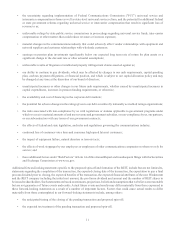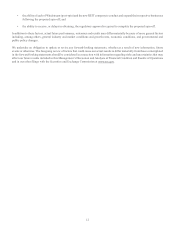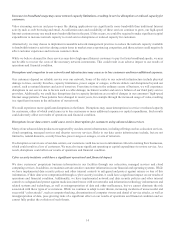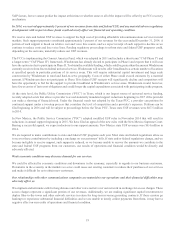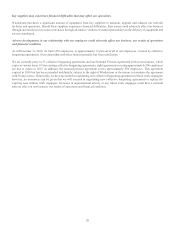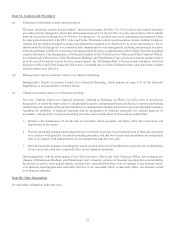Windstream 2014 Annual Report Download - page 92
Download and view the complete annual report
Please find page 92 of the 2014 Windstream annual report below. You can navigate through the pages in the report by either clicking on the pages listed below, or by using the keyword search tool below to find specific information within the annual report.16
We may need to defend ourselves against lawsuits or claims that we infringe upon the intellectual property rights of others.
From time to time, we receive notices from third parties, or we are named in lawsuits filed by third parties, claiming we have
infringed or are infringing upon their intellectual property rights. We may receive similar notices or be involved in similar lawsuits
in the future. In certain situations, we may have the ability to seek indemnification from our vendors regarding these lawsuits or
claims. If we cannot enforce our indemnification rights or if our vendors lack the financial means to indemnify us, these claims
may require us to expend significant time and money defending our alleged use of the affected technology, may require us to enter
into licensing agreements requiring one-time or periodic royalty payments that we would not otherwise have to pay or may require
us to pay damages. If we are required to take one or more of these actions, it may result in an adverse impact to our results of
operations and financial condition. In addition, in responding to these claims, we may be required to stop selling or redesign one
or more of our products or services, which could adversely affect the way we conduct our business.
The level of returns on our pension plan investments and changes to the actuarial assumptions used to value our pension
obligations could have a material effect on our earnings and result in material funding requirements to meet our pension
obligations.
Our pension plan invests in marketable securities, including marketable debt and equity securities denominated in foreign
currencies, which are exposed to changes in the financial markets. During 2014, the fair market value of these investments increased
from $959.7 million to $1,042.0 million due to the return on assets held of $144.6 million and employer contributions of Windstream
common stock and certain company-owned real estate properties totaling $89.9 million. The increases were partially offset by
routine benefit payments of $65.6 million and lump sum payments and administrative expenses of $86.6 million. Returns generated
on plan assets have historically funded a large portion of the benefits paid under our pension plan.
Funding requirements may increase as a result of a decline in the market value of plan assets, a decline in the interest rates used
to calculate the present value of future plan obligations or government regulations that increase minimum funding requirements
of the pension liability. We estimate that the long term rate of return on plan assets will be 7.0 percent, but returns below this
estimate could significantly increase our contribution requirements, which could adversely affect our cash flows from operations.
Also, reductions in discount rates and extensions of participant mortality rates directly increase our pension liability and expose
us to greater funding obligations in the future. Our earnings reported under accounting principles generally accepted in the United
States (“U.S. GAAP”) may also be adversely affected due to our method of accounting for pension costs, whereby we immediately
recognize gains and losses resulting from the return on plan assets as well as other changes in actuarial assumptions impacting
our discount rate and mortality estimates.
Our substantial debt could adversely affect our cash flow and impair our ability to raise additional capital on favorable terms.
As of December 31, 2014, we had approximately $8,651.7 million long-term debt outstanding, including current maturities. We
may also obtain additional long-term debt to meet future financing needs or to fund potential acquisitions, subject to certain
restrictions under our existing indebtedness, which would increase our total debt. Our substantial amount of debt could have
negative consequences to our business. For example, it could:
Increase our vulnerability to general adverse economic and industry conditions;
Require us to dedicate a substantial portion of cash flows from operations to interest and principal payments on outstanding
debt, thereby limiting the availability of cash flow to fund future capital expenditures, working capital and other general
corporate requirements;
Limit our flexibility in planning for, or reacting to, changes in our business and the telecommunications industry;
Place us at a competitive disadvantage compared with competitors that have less debt; and
Limit our ability to borrow additional funds, even when necessary to maintain adequate liquidity.
In addition, our ability to borrow funds in the future will depend in part on the satisfaction of the covenants in our credit facility
and its other debt agreements. If we are unable to satisfy the financial covenants contained in those agreements, or are unable to
generate cash sufficient to make required debt payments, the lenders and other parties to those arrangements could accelerate the
maturity of some or all of our outstanding indebtedness.







